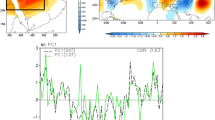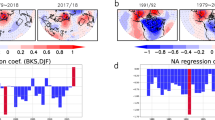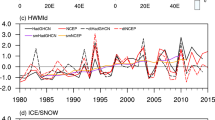Abstract
The Barents-Kara Seas are the crucial regions to link the Arctic to the midlatitudes of Eurasia, and winter warm anomalies around these regions have been regarded as a primary reason for cold-Eurasia over the past decade. Thus, the role of cold-Eurasia in resulting Arctic warm anomalies remains unclear. Through observational analyses and simulation experiments forced by prescribed regional ground albedo in Eurasia, this study shows that cold-Eurasia can give rise to Arctic warm anomalies. Observational analyses suggest that winter warm anomalies over the Barents-Kara Seas are originated from atmospheric circulation anomalies in the mid- and high-latitudes and dominantly associated with the positive NAO and the strengthening of the Siberian high. The strengthened Siberian high well corresponds to a systematic northward shift of atmospheric circulation over northern Eurasia, the North Atlantic, and northern North America, leading to significant increases in the atmospheric total energy transport into the Barents-Kara Seas. All simulation experiments consistently demonstrate that a regional cooling directly contributes to Arctic warm anomalies, and sometimes the cooling enhances the Siberian high and generates positive 500-hPa height anomalies over around the Ural Mountains through atmospheric subsidence anomalies and energy propagations, leading to warm anomalies over the Barents-Kara Seas. The increase in winter Eurasian snow cover, as one of the crucial factors enhancing the ground albedo, would favor the occurrence of warm Arctic-cold Eurasia, and there is already evidence supporting this deduction. This study implies that on the interannual time scales, winter warm anomalies over the Barents-Kara Seas cannot simply be seen as the cause of winter cold-Eurasia.











Similar content being viewed by others
Data Availability
The NCEP-NCAR Reanalysis I dataset is available at https://psl.noaa.gov/data/gridded/data.ncep.reanalysis.pressure.html. The monthly mean NAO index and Niño3.4 SST index are downloaded from https://www.cpc.ncep.noaa.gov/. Monthly Eurasian snow cover area data are used from https://climate.rutgers.edu/snowcover/.
Change history
01 November 2022
A Correction to this paper has been published: https://doi.org/10.1007/s00382-022-06548-y
References
AMAP (2021) Arctic climate change update 2021: Key trends and impacts, summary for policy-makers (http://www.amap.no)
Barnes EA, Screen JA (2015) The impact of Arctic warming on the midlatitude jet-stream: Can it? Has it? Will it? Wiley Interdisciplinary Reviews: Climate Change 6(3):277–286. https://doi.org/10.1002/wcc.337
Blackport R, Screen JA, van der Wiel K, Bintanja R (2019) Minimal influence of reduced Arctic sea ice on coincident cold winters in mid-latitudes. Nat Clim Chan 9(9):697–704
Blackport R, Screen JA (2020) Weakened evidence for mid-latitude impacts of Arctic warming. Nat Clim Chan 10(12):1065–1066. https://doi.org/10.1038/s41558-020-00954-y
Chen H, Alley R, Zhang F (2016) Interannual Arctic sea ice variability and associated winter weather patterns: A regioanl perspective for 1979–2014. J Geophys Research-Atmosphere 121:14433–14455. Doi:https://doi.org/10.1002/2016JD024769
Chen L, Francis J, Hanna E (2018) The “Warm-Arctic/Cold‐continents” pattern during 1901–2010. Int J Climatol 38(14):5245–5254
Chen S, Wu R, Chen W, Song L, Cheng W, Shi W (2021) Weakened impact of autumn Arctic sea ice concentration change on the subsequent winter Siberian High variation around the late-1990s. Int J Clamatol 41:E2700–E2717
Cohen J, Screen JA, Furtado JC, Barlow M, Whittleston D, Coumou D et al (2014) Recent Arctic amplification and extreme mid-latitude weather. Nat Geosci 7(9):627–637. https://doi.org/10.1038/ngeo2234
Cohen J, Pfeiffer K, Francis JA (2018) Warm Arctic episodes linked with increased frequency of extreme winter weather in the United States. Nat Commun 9(1):869. https://doi.org/10.1038/s41467-018-02992-9
Cohen J, Zhang X, Francis J, Jung T, Kwok R, Overland J et al (2020) Divergent consensuses on Arctic amplification influence on mid-latitude severe winter weather. Nat Clim Chang 10(1):20–29. https://doi.org/10.1038/s41558-019-0662-y
Cohen J, Agel L, Barlow M, Garfinkel CI, White I (2021) Linking Arctic variability and change with extreme winter weather in the United States. Science 373(6559):1116–1121. DOI: https://doi.org/10.1126/science.abi9167
Dai A, Song M (2020) Little influence of Arctic amplification on mid-latitude climate. Nat Clim Chang 10(3):231–237. https://doi.org/10.1038/s41558-020-0694-3
Deser C, Magnusdottir G, Saravanan R, Phillips A (2004) The effects of North Atlantic SST and sea ice anomalies on the winter circulation in CCM3. Part II: Direct and indirect components of the response. J Clim, 17(5), 877–889. https://doi.org/10.1175/1520-0442(2004)0172.0.CO;2
Ding YH, Krishnamurti TN (1987) Heat budget of the Siberian high and the winter monsoon. Mon Wea Rev 115(10):2428–2449
Ding QH, Wallace JM, BattistiDS, Steig EJ, Gallant A, Kim HJ et al (2014) Tropical forcing of the recent rapid Arctic warming in northeastern Canada and Greenland. Nature 509(7499):209–212. https://doi.org/10.1038/nature13260
Ding S, Wu B (2021) Linkage between autumn sea ice loss and ensuing spring Eurasian temperature. Clim Dyn 57(9):2793–2810. https://doi.org/10.1007/s00382-021-05839-0
Ding S, Wu B, Chen W (2021) Dominant Characteristics of Early Autumn Arctic Sea Ice Variability and Its Impact on Winter Eurasian Climate. J Clim 34(5):1825–1846. https://doi.org/10.1175/JCLI-D-19-0834.1
Francis JA, Vavrus SJ (2012) Evidence linking Arctic amplification to extreme weather in mid-latitudes. Geophys Res Lett 39(6):L06801. https://doi.org/10.1029/2012GL051000
Feng C, Wu B (2015) Enhancement of winter Arctic warming by the Siberian high over the past decade. Atmos Ocean Sci Lett 8:257–263. doi:https://doi.org/10.3878/AOSL20150022
Graversen RG (2006) Do changes in the midlatitude circulation have any impact on the Arctic surface air temperature trend? J Clim 19(20):5422–5438. https://www.jstor.org/stable/26259302
Graversen RG, Mauritsen T, Tjernström M, Källén E, Svensson G (2008) Vertical structure of recent Arctic warming. Nature 541(3):53–56. doi:10.10.38/nature06502
He SP, Xu XP, Furevik T, Gao YQ (2020) Eurasia Cooling Linked to the Vertical Distribution of Arctic Warming. Geophys Res Lett 47(10). https://doi.org/10.1029/2020GL087212. e2020GL087212
Honda M, Inous J, Yamane S (2009) Influence of low Arctic sea-ice minima on anomalously cold Eurasian winters. Geophys Res Lett 36(8):L08707. https://doi.org/10.1029/2008GL037079
Hurrell JW, James JH, Dennis S, Julie MC, James R (2008) A New Sea Surface Temperature and Sea Ice Boundary Dataset for the Community Atmosphere Model. J Clim 21(19):5145–5153. https://doi.org/10.1175/2008JCLI2292.1
Inoue J, Hori M, Takaya K (2012) The role of Barents Sea ice in the wintertime cyclone track and emergence of a warm-Arctic cold-Siberian anomaly. J Clim 25(7):2561–2568. doi:https://doi.org/10.1175/JCLI-D-11-00449.1
Kim B, Son S, Min S, Jeong J, Kim S, Zhang X, Shim T, Yoon J (2014) Weakening of the stratospheric polar vortex by Arctic sea-ice loss. Nat Commun 5:4646
Kug J, Jeong J, Jang Y, Kim B, Folland C, Min S, Son S (2015) Two distinct influences of Arctic warming on cold winters over North America and East Asia. Nat Geosci 8(10):759–762. https://doi.org/10.1038/ngeo2517
Labe Z, Peings Y, Magnusdottir G(2020) Warm Arctic, Cold Siberia Pattern: Role of Full Arctic Amplification Versus Sea Ice Loss Alone. Geophys Res Lett, 47(17), e2020GL088583. https://doi.org/10.1029/2020GL088583
Lind S, Ingvaldsen RB, Furevik T (2018) Arctic warming hotspot in the northern Barents Sea linked to declining sea-ice import. Nat Clim Chang 8(7):634–639. https://doi.org/10.1038/s41558-018-0205-y
McCusker K, Fyfe J, Sigmond M (2016) Twenty-five winters of unexpected Eurasian cooling unlikely due to Arctic sea-ice loss. Nat Geosci 9(11):838–842. https://doi.org/10.1038/ngeo2820
Mori M, Watanabe M, Shiogama H, Inoue J, Kimoto M (2014) Robust Arctic sea-ice influence on the frequent Eurasian cold winters in past decades. Nat Geosci 7(12):869–873. https://doi.org/10.1038/ngeo2277
Mori M, Kosaka Y, Watanabe M, Nakamura H, Kimote M (2019) A reconciled estimate of the influence of Arctic sea-ice loss on recent Eurasian cooling. Nat Clim Change 9:123–129. Doi:https://doi.org/10.1038/s41558-018-0379-3
Nakamura T, Yamazaki K, Iwamoto K, Honda M, Miyoshi Y, Ogawa Y, Ukita J (2015) A negative phase shift of the winter AO/NAO due to the recent Arctic seaice reduction in late autumn. J Geophys Res Atmos 120(8):3209–3227. https://doi.org/10.1002/2014JD022848
Neale RB, Richter JH, Conley AJ, Park S, Lauritzen PH, Gettelman A et al (2010) Description of the NCAR Community Atmosphere Model (CAM 4.0). NCAR Technical Note, p 212
Neale R, Chen C, Gettelman A, Lauritzen P, Park S, Williamson D et al(2012) Description of the NCAR Community Atmosphere Model (CAM 5.0). NCAR Technical Note NCAR/TN-486 + STR, 274 pp (http://www.cesm.ucar.edu/models/cesm1.0/cam/docs/description/cam5_desc.pdf)
Newson RL (1973) Response of a general circulation model of the atmosphere to removal of the Arctic ice-cap. Nature 241:39–40
Overland JE, Wood KR, Wang M (2011) Warm Arctic–cold continents: Climate impacts of the newly open Arctic Sea. Polar Res 30(1):15787. https://doi.org/10.3402/polar.v30i0.15787
Overland JE, Francis JA, Hall R, Hanna E, Kim S-J, Vihma T (2015) The melting Arctic and mid-latitude weather patterns: Are they connected? J Clim 28(20):7917–7932. https://doi.org/10.1175/JCLI-D-14-00822.1
Overland JE, Ballinger TJ, Cohen J, Francis JA, Hanna E, Jaiser R et al (2021) How do intermittency and simultaneous processes obfuscate the Arctic influence on midlatitude winter extreme weather events? Environ Res Lett 16(4):043002
Peings Y, Magnusdottir G (2014) Response of the wintertime Northern Hemisphere atmospheric circulation to current and projected Arctic sea ice decline: A numerical study with CAM5. J Clim 27(1):244–264. Doi:https://doi.org/10.1175/JCLI-D-13-00272.1
Peings Y (2019) Ural blocking as a driver of early-winter stratospheric warmings. Geophys Res Lett 46(10):5460–5468. https://doi.org/10.1029/2019GL082097
Peings Y, Labe ZM, Magnusdottir G (2021) Are 100 ensemble members enough to capture the remote atmospheric response to + 2{degree sign} C Arctic sea ice loss? J Clim 34(10):3751–3769
Petoukhov V, Semenov VA (2010) A link between reduced Barents-Kara sea ice and cold winter extremes over northern continents. J Geophys Res Atmos 115:D21111. https://doi.org/10.1029/2009JD013568
Perlwitz J, Hoerling M, Dole R (2015) Arctic tropospheric warming: causes and linkages to lower latitudes. J Clim 28(6):2154–2167. https://doi.org/10.1175/JCLI-D-14-00095.1
Polyakov IV, Pnyushkov AV, Alkire MB, Ashik IM, Baumann TM, Carmack EC et al (2017) Greater role for Atlantic inflows on sea-ice loss in the Eurasian basin of the Arctic ocean. Science 356(6335):285–291. DOI: https://doi.org/10.1126/science.aai8204
Royer JF, Planton S, Deque M (1990) A sensitivity experiment for the removal of Arctic sea ice with the French spectral general circulation model. Clim Dyn 5:1–17
Rudeva I, Simmonds I (2021) Midlatitude winter extreme temperature events and connections with anomalies in the Arctic and tropics. J Clim 34(10):3733–3749. https://doi.org/10.1175/JCLI-D-20-0371.1
Sato K, Inoue J, Watanabe M (2014) Influence of the Gulf Stream on the Barents sea ice retreat and Eurasian coldness during early winter. Environ Res Lett 9(8):084009
Screen JA, Simmonds I (2010) The central role of diminishing sea ice in recent Arctic temperature amplification. Nature 464(7293):1334–1337. doi:https://doi.org/10.1038/nature09051
Screen JA, Simmonds I (2011) Erroneous Arctic temperature trends in the ERA-40 reanalysis: A closer look. J Clim 24(10):2
Screen JA, Francis J (2016) Contribution of sea-ice loss to Arctic amplification is regulated by Pacific Ocean decadal variability. Nat Clim Chang 6(9):856–860. https://doi.org/10.1038/nclimate3011
Screen JA, Deser C, Smith DM, Zhang X, Blackport R, Kushner PJ et al (2018) Consistency and discrepancy in the atmospheric response to Arctic sea-ice loss across climate models. Nat Geosci 11(3):155–163. https://doi.org/10.1038/s41561-018-0059-y
Semenov VA, Latif M (2015) Nonlinear winter atmospheric circulation response to Arctic sea ice concentration anomalies for different periods during 1966–2012. Environ Res Lett 10:054020
Siew PYF, Li C, Sobolowski SP, King MP (2020) Intermittency of Arctic-mid-latitude teleconnections: stratospheric pathway between autumn sea ice and the winter North Atlantic Oscillation. Weather Clim Dyn 1(1):261–275. https://doi.org/10.5194/wcd-1-261-2020
Smith KL, Neely RR, Marsh DR, Polvani LM (2014) The Specified Chemistry Whole Atmosphere Community Climate Model (SC-WACCM). J Adv Model Earth Syst 6:883–901. https://doi.org/10.1002/2014MS000346
Smith DM, Screen JA, Deser C, Cohen J, Fyfe JC, García-Serrano J et al (2019) The Polar Amplification Model Intercomparison Project (PAMIP) contribution to CMIP6: investigating the causes and consequences of polar amplification. Geosci Model Dev 12(3):1139–1164. https://doi.org/10.5194/gmd-12-1139-2019
Sun L, Perlwitz J, Hoerling M (2016) What caused the recent “Warm Arctic, Cold Continents” trend pattern in winter temperatures? Geophys Res Lett 43(10):5345–5352. https://doi.org/10.1002/2016GL069024
Sung MK, Kim SH, Kim BM, Choi YS (2018) Interdecadal variability of the warm Arctic and cold Eurasia pattern and its North Atlantic origin. J Clim 31(15):5793–5810
Tang Q, Zhang X, Yang X, Francis JA (2013) Cold winter extremes in northern continents linked to Arctic sea ice loss. Environ Res Lett 8(1):014036. Doi:https://doi.org/10.1088/1748-9326/8/1/014036
Tsubouchi T, Våge K, Hansen B, Larsen KMH, Østerhus S, Johnson C et al (2021) Increased ocean heat transport into the Nordic Seas and Arctic Ocean over the period 1993–2016. Nat Clim Chang 11(1):21–26. https://doi.org/10.1038/s41558-020-00941-3
Vihma T (2014) Effects of Arctic Sea Ice decline on weather and climate: a review. Surv Geophys 35(5):1175–1214. https://doi.org/10.1007/s10712-014-9284-0
Wallace JM, Held IM, Thompson DWJ, Trenberth KE, Walsh JE (2014) Global warming and winter weather. Science 343(6172):729–730. DOI: https://doi.org/10.1126/science.343.6172.729
Walsh JE (2014) Intensified warming of the Arctic: causes and impacts on middle latitudes. Glob Planet Change 117:52–63. https://doi.org/10.1016/j.gloplacha.2014.03.003
Warner JL, Screen JA, Scaife AA (2019) Links between Barents-Kara sea ice and the extratropical atmospheric circulation explained by internal variability and tropical forcing. Geophys Res Lett 47(1). https://doi.org/10.1029/2019GL085679. e2019GL085679
Wu B, Huang R, Gao D (1999) Effects of variation of winter sea-ice area in Kara and Barents seas on East Asian winter monsoon. Acta Meteorologica Sinica 13:141–153
Wu B, Wang J (2002a) Winter Arctic Oscillation, Siberian high and East Asian winter monsoon. Geophys Res Lett 29(19):1897. https://doi.org/10.1029/2002GL015373
Wu B, Wang J (2002b) Possible impacts of winter Arctic Oscillation on Siberian high, the East Asian winter monsoon and sea-ice extent. Adv Atmos Sci 19(2):297–320
Wu B, Su J, Zhang R (2011) Effects of autumn-winter Arctic sea ice on winter Siberian high. Chin Sci Bull 56(3):3220–3228. doi:https://doi.org/10.1007/s11434-011-4696-4
Wu B, Handorf D, Dethloff K, Rinke A, Hu A (2013) Winter weather patterns over northern Eurasia and Arctic sea ice loss. Mon Wea Rev 141:3786–3800. DOI: https://doi.org/10.1175/MWR-D-13-00046.1
Wu B (2017) Winter atmospheric circulation anomaly associated with recent Arctic winter warm anomalies. J Clim 30(21):8469–8479. https://doi.org/10.1175/JCLI-D-17-0175.1
Wu B, Yang K, Francis JA (2017) A Cold Event in Asia during January-February 2012 and its possible association with Arctic sea-ice loss. J Clim 30(19):7971–7990. https://doi.org/10.1175/JCLI-D-16-0115.1
Wu B, Li ZK, Francis JA, Ding S (2022) A recent weakening of winter temperature association between Arctic and Asia. Environ Res Lett. doi:https://doi.org/10.1088/1748-9326/ac4b51
Wu Q, Zhang X (2010) Observed forcing-feedback processes between Northern Hemisphere atmospheric circulation and Arctic sea ice coverage. J Phys Res 115:D14119. doi:https://doi.org/10.1029/2009JD013574
Yao Y, Luo D, Dai A, Simmonds I (2017) Increased quasi stationarity and persistence of winter Ural blocking and Eurasian extreme cold events in response to Arctic warming Part I: insights from observational analyses. J Clim 30(10):3549–3568. https://doi.org/10.1175/JCLI-D-16-0261.1
Funding
We thank Dr. Qikai Yu for performing WACCM simulation experiments. This study is supported jointly by the Major Program of the National Natural Science Foundation of China (Grant 41790472), the National Key Basic Research Project of China (Grant 2019YFA0607002), the Key Program of National Natural Science Foundation of China (Grant 41730959), and the National Natural Science Foundation of China (Grant 41905058).
Author information
Authors and Affiliations
Corresponding author
Ethics declarations
Conflict of interest
The authors have not disclosed any competing interests.
Additional information
Publisher’s Note
Springer Nature remains neutral with regard to jurisdictional claims in published maps and institutional affiliations.
The original online version of this article was revised: The missed table 1 has been updated in the original article.
Rights and permissions
Springer Nature or its licensor holds exclusive rights to this article under a publishing agreement with the author(s) or other rightsholder(s); author self-archiving of the accepted manuscript version of this article is solely governed by the terms of such publishing agreement and applicable law.
About this article
Cite this article
Wu, B., Ding, S. Cold-Eurasia contributes to arctic warm anomalies. Clim Dyn 60, 4157–4172 (2023). https://doi.org/10.1007/s00382-022-06445-4
Received:
Accepted:
Published:
Issue Date:
DOI: https://doi.org/10.1007/s00382-022-06445-4




